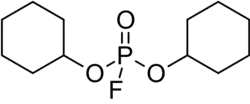Dicyclohexyl phosphorofluoridate
 | |
| Names | |
|---|---|
| Other names
DCFP
Dicyclohexyl fluorophosphate TL-941 T-1840 | |
| Identifiers | |
3D model (JSmol)
|
|
| ChemSpider | |
PubChem CID
|
|
CompTox Dashboard (EPA)
|
|
| |
| |
| Properties | |
| C12H22FO3P | |
| Molar mass | 264.277 g·mol−1 |
| Appearance | Colorless liquid |
| Boiling point | 116 °C (241 °F; 389 K) |
| Hazards | |
| Occupational safety and health (OHS/OSH): | |
Main hazards
|
Extremely toxic |
| Lethal dose or concentration (LD, LC): | |
LC50 (median concentration)
|
110 mg/m3 (inhalation, mice, 10 minutes) 110 mg/m3 (inhalation, rabbits, 10 minutes) 110 mg/m3 (inhalation, rats, 10 minutes) |
Except where otherwise noted, data are given for materials in their standard state (at 25 °C [77 °F], 100 kPa).
Infobox references
| |
Dicyclohexyl phosphorofluoridate (DCFP),[1] also known as TL-941 or T-1840,[2] is an extremely toxic organophosphorus compound with powerful anticholinesterase action. It's a colorless liquid that is extremely resistant to hydrolysis.[3] DCFP can be produced by reaction of cyclohexanol with phosphoryl dichloride fluoride.[2][3]
See also
References
- ^ BERRY, WK (October 1951). "The turnover number of cholinesterase". Biochemical Journal. 49 (5): 615–20. doi:10.1042/bj0490615. PMC 1197565. PMID 14886354.
- ^ a b Chemical Warfare Agents, and Related Chemical Problems. Parts I-II. 1958.
- ^ a b Some Aspects Of The Chemistry And Toxic Action Of Organic Compounds Containing Phosphorus And Fluorine. 1957.